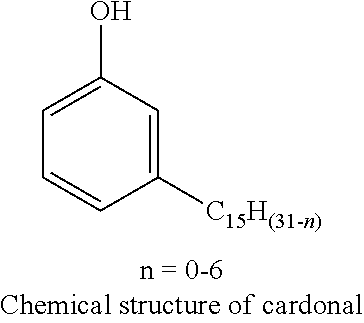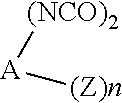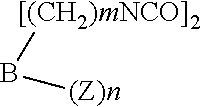Cardanol blocked isocyanate adhesion promotor for PVC plastisol
a technology of isocyanate and adhesion promotor, which is applied in the field of cardanol blocking isocyanate adhesion promotor for pvc plastisol, can solve the problems of poor environmental and health profile of phenols and current restrictions on their use in the industry, and achieves excellent storage stability, good rheological properties, and strong adhesion
- Summary
- Abstract
- Description
- Claims
- Application Information
AI Technical Summary
Benefits of technology
Problems solved by technology
Method used
Image
Examples
example 1
on of Cardanol Blocked Isocyanate Compositions
[0081]Diisodecylphthalate (294.16 g) and cardanol (80.16 g, 0.27 mole) were charged to a dry reactor. The mixture was dried under vacuum (10 mm Hg) and nitrogen sparge to achieve <0.03 wt. % water. It was then heated to 77-82° C. The polyisocyanate (Coronate 2030*), (117 g, 50% in butyl acetate) and Dabco T-12 (0.15 g) were then added. The butyl acetate was distilled at <132-135° C. The temperature of the mixture was reduced to 55° C. and EPON 828 (77.12 g, 0.20 mole) added at <55-60° C. The product was cooled to room temperature.
example 2
on of Cardanol Blocked Isocyanate Compositions with 10% Less Isocyanate
[0082]Diisodecylphthalate (294.16 g) and cardanol (80.16 g, 0.27 mole) were charged to a dry reactor. The mixture was dried under vacuum (10 mm Hg) and nitrogen sparge to achieve <0.03 wt. % water. It was then heated to 77-82° C. The polyisocyanate (Coronate 2030*), (105 g, 50% in butyl acetate) and Dabco T-12 (0.15 g) were then added. The butyl acetate was distilled at <132-135° C. The mixture was cooled to 55° C. and EPON 828 (77.12 g, 0.20 mole) added at <55-60° C. The product was cooled to room temperature.
example 3
on of Cardanol Blocked Isocyanate Compositions with 10% More Isocyanate
[0083]Diisodecylphthalate (294.16 g) and cardanol (80.16 g, 0.27 mole) were charged to a dry reactor. The mixture was dried under vacuum (10 mm Hg) and nitrogen sparge to achieve <0.03 wt. % water. It was then heated to 77-82° C. The polyisocyanate (Coronate 2030*), (129 g, 50% in butyl acetate) and Dabco T-12 (0.15 g) were then added. The butyl acetate was distilled at <132-135° C. The mixture was cooled to 55° C. and EPON 828 (77.12 g, 0.20 mole) added at <55-60° C. The product was cooled to room temperature. *Coronate 2030 is a product of Tosoh Corporation.
PUM
| Property | Measurement | Unit |
|---|---|---|
| temperature | aaaaa | aaaaa |
| temperature | aaaaa | aaaaa |
| temperature | aaaaa | aaaaa |
Abstract
Description
Claims
Application Information
 Login to View More
Login to View More - R&D Engineer
- R&D Manager
- IP Professional
- Industry Leading Data Capabilities
- Powerful AI technology
- Patent DNA Extraction
Browse by: Latest US Patents, China's latest patents, Technical Efficacy Thesaurus, Application Domain, Technology Topic, Popular Technical Reports.
© 2024 PatSnap. All rights reserved.Legal|Privacy policy|Modern Slavery Act Transparency Statement|Sitemap|About US| Contact US: help@patsnap.com










